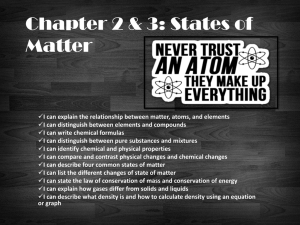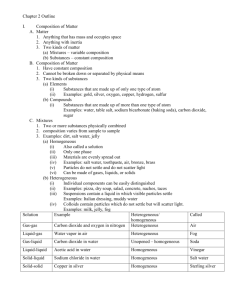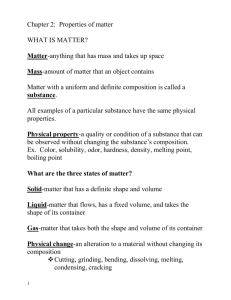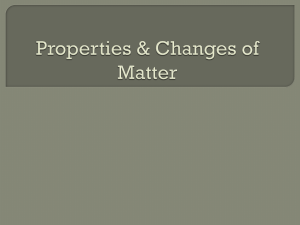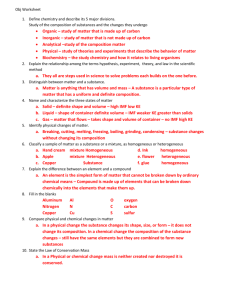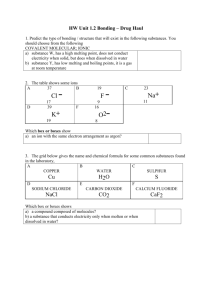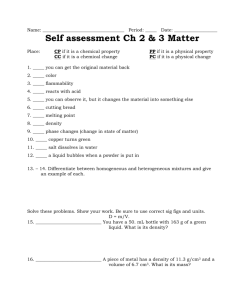Matter
advertisement
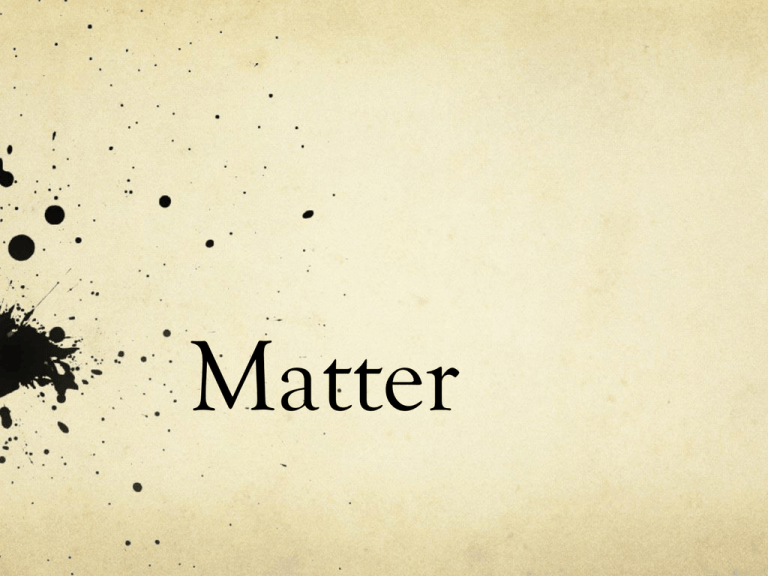
Matter What is Matter? Matter is anything that has mass and occupies space. (Mass=measure of the amount of matter in an object) Everything you can touch or hold is matter. Look around the room and give examples of Matter. Examples: you, books, air, paper… anything really States of Matter Solids Liquid Definition: Atoms are tightly packed together. Definition: Not tightly packed together allowing movement Gas Plasma Definition: Atoms not touching each other, but rather floating around Properties of Matter Physical Properties – Describes Matter Physical Properties examples: Chemical Properties – Describes how a substance reacts Chemical Properties examples: Color Texture Odor Size Toxicity Shape Melting point Combustion Boiling point Malleability Density flammability Oxidation Matter There are two types of Matter: 1. Pure substances Elements Compounds 2. Mixtures Homogeneous (Same all the way throughout) Heterogeneous (Different throughout) Matter is everything that has Mass and takes up space. Pure Substances: Cannot Be broken down into simpler compounds and still A maintain the same properties Mixtures: Made of two or more substances and can easily be separated All pure substances are homogeneous Elements Examples: Silver Gold Oxygen Hydrogen Carbon Compounds Examples: Salt Carbon Dioxide Water MgBr2 Homogeneous (Same Throughout) Examples: Kool-Aid Coffee Salt Water Air Hershey Bar Heterogeneous (Different Throughout) Examples: Hershey Bar (with Almonds) Pizza Vegatable soup Salad Classify the following examples as heterogeneous or homogeneous: Hershey Bar Snickers Bar Pizza Italian Dressing Hot Chocolate Mini Lab: Homogeneous vs. Heterogeneous Kool Aid Trail Mix TAKE A BREAK! Lab # 1 Element, Compound, or Mixture? Changes of Matter There are two types of changes that can occur. Physical Change Chemical Change Physical Change vs. Chemical Change Chemical Change: A change that occurs to produce new substances (cannot be reversed) Physical Change: A change that does not produce a new substance (can be reversed) Color Change Tearing Production of heat/light Cutting Formation of precipitation Folding Formation of Gas Painting Example: Rust Melting Example: Baking Freezing Example: Food Digestion Boiling Example Rotting Dissolving Example: Leaves changing color Example: Ice Cubes melting Classify the following as a physical or chemical change 1. Tearing Paper 2. Boiling Water 3. Making Kool-aid 4. Teeth Rotting Questions Pg. 58 1-7 Matter Changes by Adding or Removing Energy (aka Heat) Freezing D. Liquid/Gas E.Gas Condensing T (C) Melting Vapor C.Liquid B. Solid/Liquid A. Solid Heat Added Lab: Physical vs. Chemical Density A measurement of how much matter is in a certain volume of a substance Low density= “light” High density = “Heavy” Determines if an object will sink or float Density = mass /volume Practice Problem #1 (density= mass/volume) Substance Density Air 0.00313 Wood (Oak) 0.85 Water 1.00 Ice 0.93 Aluminum 2.7 Lead 11.3 Gold 19.3 Ethanol 0.94 Methanol 0.79 List the items which will float on the particular sample of ice from the previous sample. Calculating Density Density Mass Volume Density Lab Law of Conservation of Mass Mass can never be created or destroyed Law of Conservation of Mass- States that matter can be changed from one form into another, but the total amount of mass remains constant. Law of Conservation of Mass
